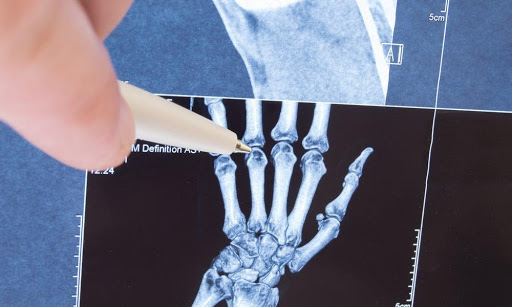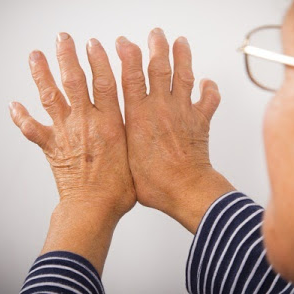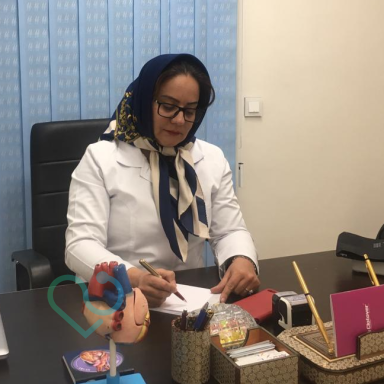Rheumatoid arthritis (RA) is an autoimmune disease that causes joint pain and damage throughout the body. The joint damage caused by RA typically occurs symmetrically, meaning if a joint in one hand or foot is affected, the same joint in the other hand or foot is likely to be affected as well. This characteristic helps distinguish RA from other forms of arthritis. The disease occurs when the immune system attacks the lining of the joints (synovium), causing inflammation. This leads to redness, swelling, and pain in the joints and can even affect the skin, eyes, lungs, heart, blood, or nerves. While the exact cause of RA is unknown, several factors can increase the risk or trigger the condition. These include a family history of RA, exposure to certain bacteria, past viral infections like the Epstein-Barr virus, trauma or injury (e.g., fractures, joint dislocations, or ligament damage), smoking, and obesity. Early diagnosis and treatment of RA are essential, making it important to recognize its symptoms.
What Are the Symptoms of Rheumatoid Arthritis?
RA is a chronic disease characterized by inflammation and joint pain. Symptoms occur during flare-ups and may completely disappear during remission periods. RA can affect multiple organs in the body, but its joint-related symptoms include:
- Joint pain
- Joint swelling
- Joint stiffness
- Loss of joint function and deformity
Symptoms may range from mild to severe but should never be ignored. Paying attention to early signs of RA can lead to faster and more effective treatment.
How Is Rheumatoid Arthritis Diagnosed?
After understanding the symptoms and medical history, the doctor performs a physical examination, which includes:
- Checking for swelling and redness in the joints
- Assessing joint function and range of motion
- Palpating affected joints for warmth and tenderness
- Testing reflexes and muscle strength
If RA is suspected, the patient is referred to a rheumatologist. Since confirming the diagnosis may require multiple tests, including blood tests and imaging (e.g., ultrasound, X-rays, or MRI), the process may take time. These tests help determine the extent and severity of joint damage.

Blood Tests for Rheumatoid Arthritis
The doctor or rheumatologist may perform various tests to diagnose this condition:
- Rheumatoid Factor (RF) Test: This test measures a protein called rheumatoid factor. High levels may indicate an autoimmune disorder.
- Anti-Cyclic Citrullinated Peptide (Anti-CCP) Test: This checks for antibodies associated with RA. Although more specific than the RF test, not all individuals with RA have these antibodies.
- Antinuclear Antibody (ANA) Test: This examines the immune system for antibody production.
- Erythrocyte Sedimentation Rate (ESR): This measures inflammation in the body without specifying its cause.
- C-Reactive Protein (CRP) Test: The liver produces CRP during infections or severe inflammation. High levels may indicate RA.
What Is the Treatment for Rheumatoid Arthritis?
Currently, there is no cure for RA, but treatments can help manage the disease. RA can be managed with medications, dietary changes, exercise, and home remedies to reduce long-term complications.
Medications for Rheumatoid Arthritis
Some medications relieve pain and inflammation, while others prevent joint damage:
- Nonsteroidal anti-inflammatory drugs (NSAIDs)
- Corticosteroids
- Acetaminophen
Medications that reduce RA-related joint damage:
- DMARDs (Disease-Modifying Antirheumatic Drugs): These suppress the immune response and prevent RA progression. Newer DMARDs may be more effective at reducing inflammation.
- JAK Inhibitors: A type of DMARD that blocks certain immune responses. These are prescribed if other DMARDs fail to prevent joint inflammation and damage.
Dietary Changes
- Consume omega-3-rich foods like fatty fish (salmon, tuna, herring), chia seeds, flaxseeds, and walnuts.
- Eat antioxidant-rich foods such as berries, dark chocolate, spinach, red kidney beans, and artichokes.
- Increase fiber intake through whole grains, vegetables, and fresh fruits, especially strawberries.
- Consume flavonoid-rich foods like soy products, broccoli, tea, and grapes to reduce inflammation.
Exercise
Gentle exercises can improve joint flexibility and mobility. Physical activities like yoga strengthen muscles and reduce joint stress.
Home Remedies for Rheumatoid Arthritis
1- Get Enough Rest
Rest, especially during flare-ups, helps reduce inflammation, pain, and fatigue.
2- Try Heat or Cold Therapy
Cold compresses can reduce inflammation, pain, and muscle spasms. Warm compresses or hot showers can alleviate stiffness.
3- Use Orthopedic and Mobility Aids
Orthopedic supports like splints can help rest joints and reduce inflammation. Using a cane can also ease movement.
The progression of RA varies among individuals, and symptoms may range from mild to severe. While treatments can manage symptoms for extended periods, joint issues typically worsen over time, making early diagnosis and treatment critical to prevent severe damage.












Our Customers' Comments
No comments registered